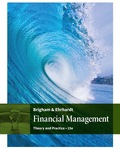
a.
To define: Real options, managerial option; managerial option; strategic option and embedded option
a.
Explanation of Solution
- Real Option: The different choices that the manager of a corporate has with regard to available investment opportunities are referred as real option. It is called real because the option or choice available is usually with respect to asset of tangible or physical nature instead of financial instrument.
These options represent the opportunities management of a corporation has to alter the different aspect of an investment such as its scale, timing and amount involved if there is a change in the existing market conditions.
- Managerial Option: Such option represents ability of a corporate’s management to take decision with respect to the future of the project’s different aspect such as its cash flows or its total life which may affect the financial viability of the project.
Different type of managerial options that might be available to a company includes:
. Option to expand the existing project in future or contract its total volume
. Option to abandon the current project or delay its implementation until fresh information is available relating to such project
- Strategic option: Action oriented response of creative nature that a company undertakes in order to deal with external situation or circumstances are referred as strategic options. Such actions are taken after undertaking an institutional evaluation of different opportunities that are available and the threat that the external environment poses to the company and its long-term goals and aspirations.
- Embedded Option: It is a component of financial instrument and security that provide the holders of such options or its issuer an opportunity to take a particular action against one another at some future point of time.
Such options are inseparable part of the security and cannot be offered on standalone basis, hence the name embedded and inclusion of such options as a bundle along with the security impacts the overall value of such securities.
b.
To define: Investment timing options, Growth options, Abandonment option and Flexibility option.
b.
Explanation of Solution
- Investment timing option: An option which provides the holder an opportunity to delay or postpone the decision to invest until there is availability of more material information which can impact the decision-making ability of the investor is referred as investment timing option.
- Growth Option: If an existing investment project has an inbuilt option to make follow up investment to expand the existing project then such option is referred as growth option. An option to build an extra lane of highway while working on the construction of 4 lane highway is an instance of growth option.
- Abandonment option: If an investment project has an option to cease or leave the project during the lifetime of such project is referred as abandonment option. Such option provides company to exit from the project as soon as it loses it financial viability and cut short its possible future losses.
- Flexibility Option: Capital budgeting decisions are of long term nature and while taking such decision management of a company faces high degree of uncertainty as different factors influencing such decision might change over a time period and in order to minimize such uncertainty there must be an option in the initial contract which can provide company an option to alter its investment plan, additional capital outlay in accordance with change in any underlying influencing factor. Such an option which provides corporation such flexibility is referred as flexibility option.
c.
To define: Decision Tree
c.
Explanation of Solution
Decision Tree: Tool that is used to analyses the decision making process by depicting different possible decisions that can be taken with regard to a prospective decision in tree like diagram along with its probable outcome, possible resource outflow and its utility is referred as decision tree.
Want to see more full solutions like this?
Chapter 26 Solutions
EBK FINANCIAL MANAGEMENT: THEORY & PRAC
- see itPlease don't answer i posted blurred image mistakely. please comment below i will write values. if you answer with incorrect values i will give unhelpful confirm.arrow_forwardNo use ai. if image is blurr or data is not showing properly then dont answer i will sure deslike. please comment i will write values.arrow_forwardDon't use ai. if image is blurr or data is not showing properly then dont answer i will sure deslike. please comment i will write values.arrow_forward
- no ai Please don't answer i posted blurred image mistakely. please comment below i will write values. if you answer with incorrect values i will give unhelpful confirm.arrow_forwardFinance SubjPlease don't answer i posted blurred image mistakely. please comment below i will write values. if you answer with incorrect values i will give unhelpful confirm.arrow_forwardcalculate ratios for the financial statment given and show all working manually: 3. TIE Ratio 4. Cash Coverage Ratioarrow_forward
- calculate ratios for the financial statment given and show all working manually: 1. Debt Ratios 2. Debt to Equityarrow_forwardcalculate the following ratios for the statements and show all working: 1. Current Ratios 2. Quick Ratio 3. Cash Ratioarrow_forwardDont solve this question with incorrect values. i will give unhelpful . do not solvearrow_forward
 Intermediate Financial Management (MindTap Course...FinanceISBN:9781337395083Author:Eugene F. Brigham, Phillip R. DavesPublisher:Cengage Learning
Intermediate Financial Management (MindTap Course...FinanceISBN:9781337395083Author:Eugene F. Brigham, Phillip R. DavesPublisher:Cengage Learning EBK CONTEMPORARY FINANCIAL MANAGEMENTFinanceISBN:9781337514835Author:MOYERPublisher:CENGAGE LEARNING - CONSIGNMENT
EBK CONTEMPORARY FINANCIAL MANAGEMENTFinanceISBN:9781337514835Author:MOYERPublisher:CENGAGE LEARNING - CONSIGNMENT Cornerstones of Cost Management (Cornerstones Ser...AccountingISBN:9781305970663Author:Don R. Hansen, Maryanne M. MowenPublisher:Cengage Learning
Cornerstones of Cost Management (Cornerstones Ser...AccountingISBN:9781305970663Author:Don R. Hansen, Maryanne M. MowenPublisher:Cengage Learning



